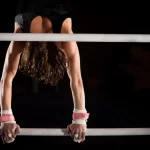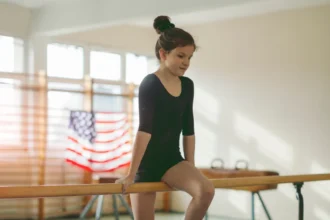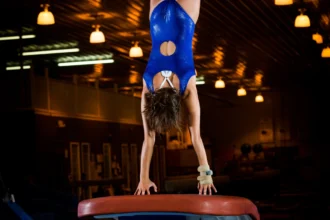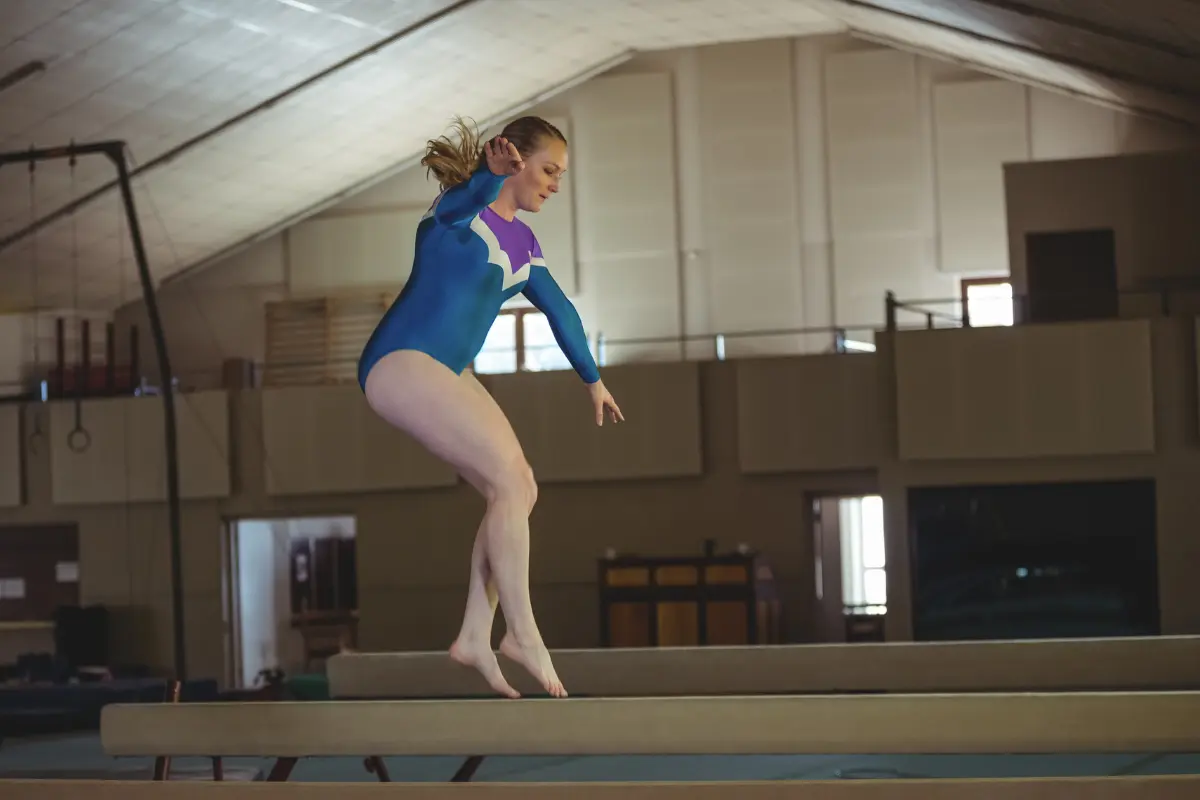Before gymnasts can swing high, perform giants, or dismount with flyaways, they first need to learn the basics—and that journey begins on the bars. From the very first pullover in Level 1, gymnasts practice tight body shapes, proper timing, and how to control their movement on and around the bar.
This guide outlines the required bar skills for Levels 1 through 5 in the USA Gymnastics 2021–2029 Compulsory Program, including what each routine teaches, which elements are performed, and key tips for success.
Level 1 Bar Routine: Building the Basics
Purpose: Introduce basic bar shapes, grip strength, and rhythm.
Required Elements:
- Pullover
- Cast
- Back hip circle
- Underswing dismount
Skill Descriptions:
- Pullover: From a stand on a panel mat, the gymnast jumps and pulls her chin above the bar, then kicks up to rotate her hips over into front support.
- Cast: Push down through the bar to lift the hips slightly while keeping the legs straight and the body tight. Aim for a cast angle between 15° and 45°.
- Back Hip Circle: A controlled backward circle around the bar while maintaining a tight body. Finish back in front support with no extra swings.
- Underswing Dismount: The gymnast leans forward, swings her legs under the bar, and releases in a hollow body shape to land.
Coach Tip: Focus on straight arms, tight legs, and pointed toes throughout. Cast angle and finish control are key for scoring.
Level 2 Bar Routine: Swing and Shape Control
Purpose: Refine casting and introduce glide swing and rhythm elements.
Required Elements:
- Pullover
- Cast
- Back hip circle
- Glide swing
- Leg cut
- Single-leg squat on
- Underswing dismount
Skill Descriptions:
- Pullover and Cast: Same as Level 1.
- Back Hip Circle: Must be tight and controlled.
- Glide Swing: Drop into a glide from front support with feet together and hips extended. Return to the bar smoothly.
- Leg Cut: Swing one leg over the bar to move into a straddle sit.
- Single-Leg Squat On: Bring one foot onto the bar and squat to a stand.
- Underswing Dismount: Release in a hollow position and land firmly.
Coach Tip: Glide swing rhythm is essential: pike forward, stretch back, and snap to support. No knee bends or unfinished swings.
Level 3 Bar Routine: Tapping and Transitions
Purpose: Introduce tap swings, bar transitions, and stronger shoulder control.
Required Elements:
- Pullover
- Cast to horizontal
- Back hip circle
- Single-leg squat on
- Jump to high bar
- Tap swings (2)
- Counterswing dismount
Skill Descriptions:
- Pullover, Cast, and Back Hip Circle: Cast must reach horizontal to avoid deductions.
- Single-Leg Squat On + Jump to High Bar: Squat to stand on low bar, then jump with straight legs to catch high bar.
- Tap Swings: Gymnast swings in a tight body position, alternating between slight arch and hollow. Feet should rise to horizontal or above.
- Counterswing Dismount: After the second tap swing, the gymnast allows the body to swing backward, then releases and lands with control.
Coach Tip: Tap swings must be consistent in shape and timing. Judges look for amplitude, no leg separation, and extended shoulders.
Level 4 Bar Routine: Circles and Kips Begin
Purpose: Introduce the kip and bar-to-bar connections.
Required Elements:
- Straddle or pike glide kip
- Cast to horizontal
- Back hip circle
- Squat on + jump to high bar
- Long hang kip
- Cast to horizontal
- Tap swing (2)
- Tap swing ½ turn dismount
Skill Descriptions:
- Glide Kip: From hang, the gymnast glides forward in a pike or straddle, then pulls the bar to her hips and rises to front support.
- Cast to Horizontal: The body must lift to horizontal with tight form.
- Back Hip Circle: Performed after the kip and cast, with control.
- Squat On + Jump to High Bar: Clean, balanced transition with no swing allowed.
- Long Hang Kip: From the high bar, the gymnast swings and lifts into front support.
- Tap Swings: Two strong swings with a controlled hollow–arch shape.
- ½ Turn Dismount: The second tap swing ends with a ½ turn release and landing facing the bar.
Coach Tip: Kips require strong shoulder timing and a fast hollow-to-arch motion. The ½ turn must be clean and not rushed.
Level 5 Bar Routine: Full Giants and Higher Difficulty
Purpose: Strengthen high bar technique and prepare for optional-level routines.
Required Elements:
- Glide kip
- Cast to above horizontal
- Clear hip circle
- Back sole circle or Stalder to clear front support
- Counterswing (from long hang kip or cast to stand)
- Jump to high bar
- Long hang kip
- Cast to above horizontal
- Tap swings (2)
- Flyaway dismount (layout preferred)
Skill Descriptions:
- Glide Kip + Cast Above Horizontal: Begin the routine with a strong kip and a high cast.
- Clear Hip Circle: A full circle backward around the bar, finishing in front support. Legs should stay straight and body tight.
- Back Sole Circle or Stalder: Both are backward circles under the bar; gymnasts choose based on flexibility and strength.
- Jump to High Bar + Long Hang Kip: Controlled transition and a strong kip to high bar.
- Cast to Above Horizontal: Prepares for the final swing phase.
- Two Tap Swings + Flyaway Dismount: The second tap swing ends with a flyaway—tuck, pike, or layout. A layout is preferred for higher artistry.
Coach Tip: Focus on shaping during the clear hip and flyaway. The rhythm and fluidity of the entire routine matter more than ever at this level.
For full skill descriptions and deductions, refer to the USA Gymnastics Women’s Development Program Compulsory Manual (2021–2029).













